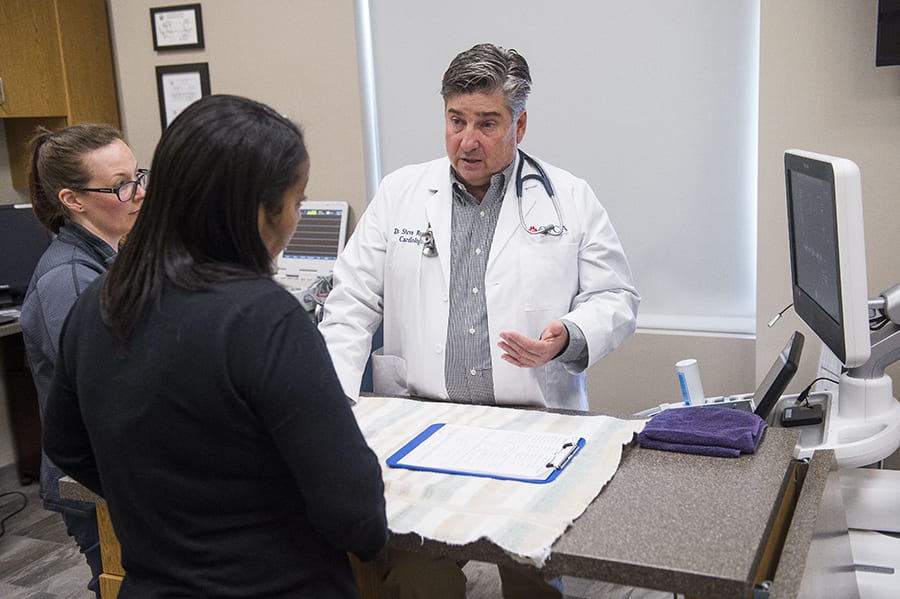The Duty of Ultrasound and CT Check in Modern Vet Practices: Insights From Experienced Professionals
In contemporary veterinary techniques, ultrasound and CT scans considerably improve diagnostic capacities. These imaging strategies give essential insights into animal health, guiding therapy choices. Experienced specialists acknowledge the distinct benefits of each modality. Ultrasound offers real-time analyses, while CT checks deliver detailed physiological details. Recognizing their applications and roles increases essential inquiries regarding their influence on person results and the future of veterinary diagnostics. What insights can be obtained from their integrated usage?
Comprehending Ultrasound in Veterinary Medication
Ultrasound is a necessary analysis tool in veterinary medicine, providing a non-invasive method to imagine internal structures. This imaging strategy employs high-frequency audio waves to create real-time photos of body organs and tissues, permitting vets to examine problems without surgical intervention. Usual applications consist of evaluating the heart, liver, kidneys, and reproductive organs, along with keeping an eye on pregnancies.The treatment is fairly quick and can be performed in numerous setups, making it an easily accessible alternative for vets. Unlike radiography, ultrasound supplies thorough info about soft tissues and blood circulation, which is essential for precise diagnoses.Veterinary specialists rely on ultrasound to detect problems such as growths, cysts, and liquid buildup. Its ability to lead biopsies and various other procedures further boosts its utility in professional technique. By offering a efficient and safe means to take a look at internal makeup, ultrasound has actually become a foundation of modern vet diagnostics.
The Benefits of CT Scans for Pet Diagnostics
CT checks deal significant advantages in vet diagnostics by providing boosted accuracy in determining interior conditions (CT Scans For Dogs). As a non-invasive imaging method, they ensure the security and convenience of animals throughout evaluations. Furthermore, CT checks facilitate a thorough assessment of interior frameworks, permitting a lot more efficient treatment preparation
Enhanced Diagnostic Accuracy
Advancements in imaging innovation have actually substantially boosted diagnostic accuracy in veterinary medicine, specifically via making use of CT scans. These scans offer thorough cross-sectional pictures of a pet's inner frameworks, permitting veterinarians to recognize abnormalities with precision. The high resolution and three-dimensional abilities of CT imaging assist in the detection of conditions such as tumors, fractures, and internal blood loss that may be missed with traditional imaging techniques. Furthermore, CT scans can aid in pre-surgical preparation by supplying a complete view of physiological connections. This level of detail not just boosts the precision of diagnoses however additionally help in customizing efficient treatment plans. As a result, the combination of CT modern technology right into vet methods is transforming the landscape of animal health care, enhancing results for patients.
Non-Invasive Imaging Method
The introduction of non-invasive imaging techniques has revolutionized pet diagnostics, with CT checks becoming a famous tool in vet methods. These scans supply high-resolution, cross-sectional pictures of a pet's inner frameworks, enabling vets to assess intricate problems without the requirement for intrusive procedures. The benefits of CT scans include their capacity to find tumors, cracks, and internal blood loss with amazing precision. Additionally, they promote the analysis of soft tissues and body organs, improving diagnostic capacities. The speed of CT scanning enables quick decision-making, which is crucial in emergency situation scenarios. By reducing stress and discomfort for the animal, CT scans add to a more humane approach to diagnostics, ultimately enhancing therapy results and progressing veterinary care.
Comprehensive Internal Analysis
A thorough interior analysis is crucial for exact diagnosis and efficient treatment in veterinary medication. CT scans deal significant benefits in this respect, providing comprehensive cross-sectional pictures of a pet's internal frameworks. This sophisticated imaging modality improves visualization of complicated anatomical areas, allowing veterinarians to determine irregularities such as tumors, fractures, and inner bleeding with better accuracy. On top of that, CT checks promote the evaluation of problems that might be testing to identify through traditional approaches. The speed and precision of CT imaging likewise contribute to timely treatments, boosting individual outcomes. As veterinary techniques significantly incorporate CT innovation, the advantages of substantial interior evaluations end up being noticeable, strengthening the value of this tool in contemporary veterinary diagnostics.
Comparing Ultrasound and CT Imaging Techniques
While both ultrasound and CT imaging offer necessary roles in veterinary diagnostics, each technique supplies distinct advantages and restrictions that can affect medical decision-making. Ultrasound is specifically valued for its real-time imaging abilities, permitting vets to observe vibrant physiological procedures. This strategy is non-invasive, portable, and does not entail ionizing radiation, making it a much safer alternative for both pets and clinicians. Ultrasound might have restrictions in visualizing certain anatomical frameworks or deep tissues.Conversely, CT imaging gives comprehensive cross-sectional views of the body, allowing for exact localization of problems. It excels in examining facility body organs and structures, specifically in the thorax and abdomen. CT scans need sedation or anesthesia in numerous cases and include direct exposure to ionizing radiation. Eventually, the selection in between ultrasound and CT relies on the details medical situation, the area of interest, and the seriousness of the diagnostic needs.
Instance Researches: Effective Diagnoses With Imaging
Case studies show the significant renovations in analysis accuracy accomplished via sophisticated imaging innovations like ultrasound and CT scans in vet methods. These advancements not just improve the discovery of various conditions however likewise promote reliable and timely therapy plans. Examining particular situations can highlight the transformative influence of these imaging strategies on veterinary medication.
Analysis Accuracy Improvements

Imaging Technology Advancements
As vet imaging technology proceeds to develop, its effect on analysis capacities becomes increasingly evident. Current instance researches highlight the successful application of sophisticated ultrasound and CT scan strategies in determining complicated problems. For circumstances, a veterinary clinic used high-resolution CT scans to diagnose an unusual type of lung cancer cells in a dog, which standard imaging had missed out on. An ultrasound assessment revealed a stomach mass in a feline, motivating timely medical intervention and a favorable end result. These advancements not just improve analysis precision however likewise allow vets to create targeted therapy plans. By leveraging advanced imaging innovations, vet experts are markedly boosting client treatment, causing much more effective monitoring of numerous wellness problems in pets.
The Role of Imaging in Emergency Vet Care
Imaging plays an important role in emergency situation vet care, supplying vets with vital details needed to make fast, educated choices. In urgent situations, methods like ultrasound and CT scans make it possible for specialists to promptly assess a pet's interior structures, identifying essential problems such as internal blood loss, cracks, or organ irregularities. These imaging techniques enable for real-time assessments, promoting prompt treatments that can be life-saving. Ultrasound is important for assessing soft tissue injuries and problems like liquid accumulation, while CT scans offer detailed pictures of complex anatomical frameworks, vital for diagnosing trauma cases. The rate and accuracy of these imaging methods enhance the veterinarian's capacity to create efficient therapy plans, guaranteeing the most effective possible end results for their patients. Subsequently, the assimilation of innovative imaging modern technologies right into emergency vet methods is not just valuable however increasingly required, as it improves analysis capabilities and improves total animal care during defining moments.
Training and Expertise in Vet Imaging
Advanced imaging strategies such as ultrasound and CT scans are crucial for effective veterinary care, the effective execution of these technologies heavily depends on the training and experience of veterinary experts. Competent use imaging devices calls for comprehensive expertise of anatomy, pathology, and the principles underlying each technique. Vet professionals need to undertake customized training to properly translate imaging outcomes, which is vital for diagnosing conditions and preparing treatment.Certifications and continuing education in veterinary imaging improve the skills of experts, allowing them to remain upgraded with technical developments. Cooperation in between vets and radiologists typically brings about boosted analysis precision, as professionals can provide insights right into intricate situations. On top of that, functional experience in handling imaging devices cultivates self-confidence in its application. Eventually, the high quality of veterinary imaging solutions is directly associated to the degree of training and experience possessed by the experts using these vital diagnostic devices.
Future Fads in Diagnostic Imaging for Animals
With the fast developments in technology, vet analysis imaging is poised for considerable evolution in the coming years. Arising trends show a change towards more mobile and obtainable imaging techniques, such as portable ultrasound tools, which might enhance area diagnostics. In addition, the assimilation of expert system is anticipated to revolutionize image evaluation, enabling quicker and much more precise interpretations of results.Moreover, innovations in 3D imaging methods and computed tomography will provide vets with more complete views of animal makeup, causing improved treatment plans. Virtual truth technology CT Scans For Animals may additionally contribute in surgical planning and education and learning, giving veterinarians an unique point of view on intricate cases.As telemedicine remains to expand, remote appointments helped with by analysis imaging will end up being extra typical, permitting specialists to help family doctors in real-time. Generally, these fads are established to boost the effectiveness and performance of veterinary care, ultimately improving pet end results.
Frequently Asked Questions
How Much Do Ultrasound and CT Checks Price in Veterinary Clinics?
The expenses of ultrasound and CT scans in vet clinics usually vary from $300 to $1,500, relying on aspects such as location, clinic type, and particular procedures required for the pet's medical diagnosis and treatment.

Are There Any Type Of Threats Associated With Ultrasound and CT Scans for Pet Dogs?
Ultrasound and CT scans typically pose very little dangers to pets. Nonetheless, potential problems consist of sedation reactions and direct exposure to anesthetics. Ultrasound For Dogs. Vets thoroughly evaluate each case to alleviate any dangers linked with these diagnostic treatments
For How Long Do Ultrasound and CT Treatments Typically Take?
Ultrasound treatments typically take around thirty minutes to an hour, depending on the intricacy. CT scans, being more thorough, usually need 30 mins to 90 minutes, consisting of prep work and recovery time for the animal.
Can All Veterinarians Perform Ultrasounds and CT Scans?
Not all veterinarians can execute ultrasounds and CT scans. Specialized training and accreditation are usually required to ensure expertise in these advanced imaging methods, which might restrict their accessibility to veterinarians with extra certifications and sources.
What Sorts Of Animals Profit Many From These Imaging Techniques?
Specific animal varieties, particularly canines and felines, benefit considerably from ultrasound and CT scans. These imaging strategies boost analysis precision for problems like lumps, inner injuries, and body organ abnormalities, resulting in enhanced treatment outcomes and person care. The high resolution and three-dimensional capabilities of CT imaging help with the detection of conditions such as lumps, cracks, and inner blood loss that may be missed with standard imaging techniques. Situation research studies show the significant improvements in diagnostic precision attained with advanced imaging technologies like ultrasound and CT scans in veterinary techniques. Improving analysis precision in veterinary techniques has actually been significantly aided by innovations in imaging modern technologies such as ultrasound and CT scans. Innovative imaging methods such as ultrasound and CT scans are vital for efficient veterinary treatment, the effective execution of these innovations greatly depends on the training and knowledge of veterinary specialists. Veterinary specialists need to go through specialized training to properly translate imaging results, which is vital for detecting problems and planning treatment.Certifications and continuing education in veterinary imaging improve the skills of professionals, allowing them to remain upgraded with technical advancements.